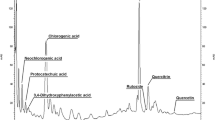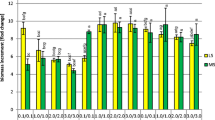Abstract
A Catharanthus roseus cell line was cultured in a 14-l bioreactor. Total alkaloid production decreased more than 80% while scaling up this cell line from 250 ml batch cultures to the bioreactor. However, the subsequent application of an osmotic stress and 1 mM trans-cinnamic acid, which inhibits the synthesis of phenolic compounds, restored the original alkaloid amounts.
Similar content being viewed by others
References
Bennet RN, Wallsgrove RM (1994) Secondary metabolites in plant defence mechanisms. New Phytol. 127: 617–633.
Bolwell GP, Cramer CL, Lamb CJ, Schuch W, Dixon RA (1986)L-phenylalanine ammonia-lyase from Phaseolus vulgaris: modulationof the levels of active enzyme by trans-cinnamic acid. Planta 169: 97–107.
DiCosmo F, Misawa M (1985) Eliciting secondary metabolism inplant cell cultures. Trends Biotechnol. 3: 318–322.
Dunlop DS, Curtis WR (1991) Synergistic response of plant hairyroot cultures to phosphate limitation and fungal elicitation. Biotechnol. Prog. 7: 434–438.
Eilert U, Constabel F, Kurz WGW (1986) Elicitor-stimulation ofmonoterpene indole alkaloid formation in suspension cultures of Catharanthus roseus. J. Plant Physiol. 126: 11–22.
Frischknecht PM, Baumann TW (1985) Stress induced formation of purine alkaloids in plant tissue cultures of Coffea Arabica. Phytochemistry 24: 2255–2257.
Godoy-Hernández G, Loyola-Vargas VM (1991) Effect of fungal homogenate, enzyme inhibitors and osmotic stress on alkaloid content of Catharanthus roseus cell suspension cultures. PlantCell Rep. 10: 537–540.
Kieran PM, MacLoughlin PF, Malone DM (1997) Plant cell suspensioncultures: some engineering considerations. J. Biotechnol. 59: 39–52.
Leckie F, Scragg AH, Cliffe KC (1991) An investigation into therole of initial KLa on the growth and alkaloid accumulation bycultures of Catharanthus roseus. Biotechnol. Bioeng. 37: 364–370.
Moreno PRH, van der Heijden R, Verpoorte R (1995) Cell and tissuecultures of Catharanthus roseus: a literature survey. Plant CellTissue Org. Cult. 24: 1–25.
Namdev PK, Dunlop EH (1995) Shear sensitivity of plant cells insuspensions. Appl. Biochem. Biotechnol. 54: 109–131.
Phillips GC, Collins GB (1979) In vitro tissue culture of selected, legumes and plant regeneration from callus cultures of red clover. Crop Sci. 19: 59–64.
Roberts SC, Shuler M (1997) Large-scale plant cell culture. Curr. Opin. Biotechnol. 8: 154–159.
Schlatmann JE, Moreno PRH, Vinke JL, ten Hoopen HJG, VerpoorteR, Heijnen JJ (1994) Effect of oxygen and nutrientlimitation on ajmalicine production and related enzymes activitiesin high density cultures of Catharanthus roseus. Biotechnol. Bioeng. 44: 461–468.
Schlatmann JE, Moreno PRH, Vinke JL, ten Hoppen HJG, Verpoorte R, Heijnen JJ (1997) Gaseous metabolites and the ajmalicineproduction rate in high density cell cultures of Catharanthusroseus. Enzyme Microbiol. Tech. 20: 107–115.
Scragg AH (1995) The problems associated with high biomass levelsin plant cell suspensions. Plant Cell Tissue Org. Cult. 43:163–170.
Seitz HU, Eilert U, De Luca V, Kurz WGW (1989) Elicitor mediated induction of phenylalanine lyase and tryptophan decarboxylase: accumulation of phenols and in dole alkaloid accumulation in cell suspension cultures of Catharanthus roseus. PlantCell Tissue Org. Cult. 18: 71–78.
Verpoorte R, van der Heijden R, ten Hoopen HJG, Memelink J(1999) Metabolic engineering of plant secondary pathways for the production of fine chemicals. Biotechnol. Lett. 21: 467–479.
Author information
Authors and Affiliations
Rights and permissions
About this article
Cite this article
Godoy-Hernández, G.C., Vázquez-Flota, F.A. & Loyola-Vargas, V.M. The exposure to trans-cinnamic acid of osmotically stressed Catharanthus roseus cells cultured in a 14-l bioreactor increases alkaloid accumulation. Biotechnology Letters 22, 921–925 (2000). https://doi.org/10.1023/A:1005672400219
Issue Date:
DOI: https://doi.org/10.1023/A:1005672400219




